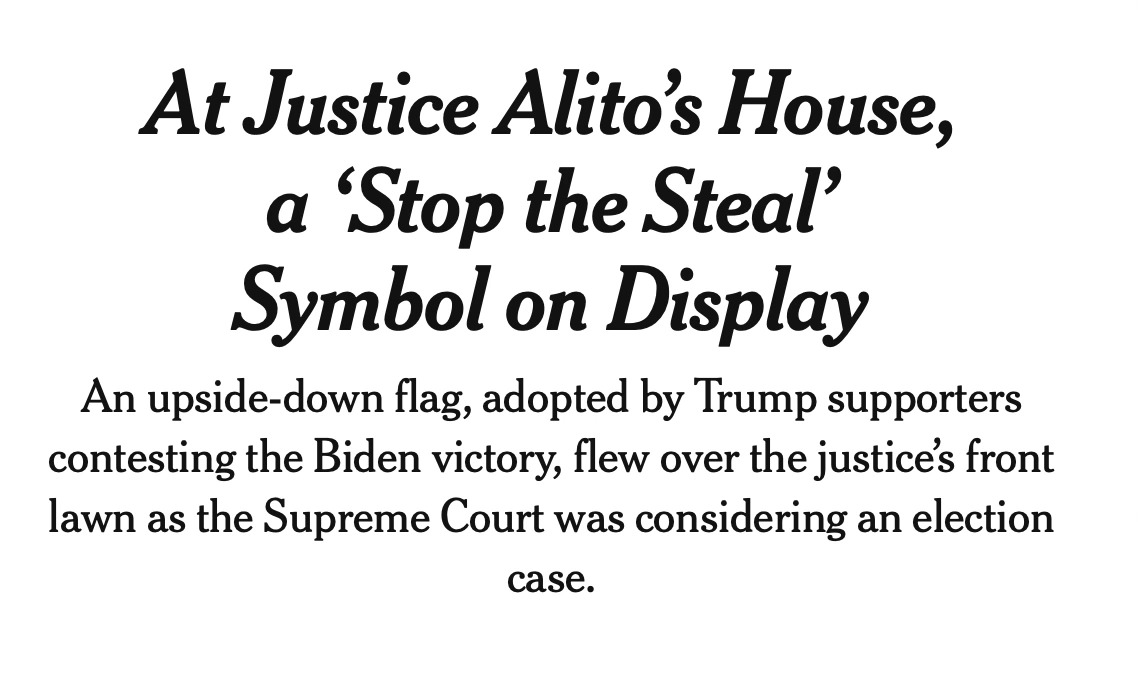A brief history of Sam Alito

From the very beginning, long before he flew insurrectionist flags over his houses, there mere fact of Sam Alito’s presence on the Supreme Court has been an affront to democracy.
In December of 2000, the Supreme Court’s Republican majority prematurely stopped a recount of ballots cast in Florida, handing the White House to a Republican presidential candidate who lost the national popular vote and, we would later learn, received fewer votes in Florida, and who would go on to appoint two more Republican Supreme Court justices, including Sam Alito.1

Alito’s presence on the Supreme Court is thus the result of a fundamentally anti-democratic quirk of our constitution and of a fundamentally anti-democratic decision by his fellow Republicans on the Supreme Court. That helps explain how Republicans have held a majority of seats on the Supreme Court for 55 consecutive years despite losing the popular vote in seven of the last eight presidential elections: The Republican majority on the Supreme Court interceded in an election to put a Republican loser in the White House where he could appoint two more Republican Supreme Court justices, perpetuating the Republican majority on the Court.
As a Supreme Court justice, Sam Alito cast the deciding vote in 2013’s Shelby County v Holder, the 5-4 decision in which the Court gutted the Voting Rights Act and unleashed a flood of Republican efforts to make it harder for Black people to vote. In 2021, Alito joined his fellow Republican justices in further weakening the Voting Rights Act in Brnovich v DNC. (When Alito applied for a job in the Reagan Justice Department, Alito touted his membership in Concerned Alumni of Princeton, a right-wing organization whose racist views he later attempted to distance himself from during his Supreme Court confirmation hearings. Probably a coincidence.)
Alito also cast the deciding vote in Citizens United v FEC, the 2010 decision in which the Court invited corporations to flood our elections with unlimited campaign spending. While expanding the political power of big corporations, Alito has used his seat on the Supreme Court to constrain the political power of everyday Americans, most notably via his tireless assault on the rights of workers to join together in unions. In Knox v. Service Employees International Union (2012) Alito wrote the Court decision imposing onerous new restrictions on labor unions neither party in the case had even sought.2 And in Janus v AFSCME (2018), Alito cast the deciding vote and wrote the majority opinion in which the Court was widely seen as “gutting public sector unions.”
In 2019, Alito cast the deciding vote in Rucho v Common Cause, opening the floodgates to undemocratic gerrymandering. In 2022, Alito cast the deciding vote to order a stay of a lower court ruling in Allen v. Milligan that would have required Alabama to re-draw its congressional maps. That stay likely handed control of the House of Representatives to the Republican Party, as it resulted in Alabama and four other states using racially-gerrymandered maps for the 2022 midterm elections.3 Just this morning, Alito once again used his seat on the Supreme Court to help Republicans draw racially discriminatory congressional maps, writing the decision in Alexander v. South Carolina Conference of the NAACP restoring GOP-drawn maps that a lower court had blocked as an illegal racial gerrymander.
So Sam Alito, who owes his seat on the Supreme Court to an anti-democracy act by the Republicans who controlled the Court before he got there, has used that seat to relentlessly attack and undermine democracy, from gutting the Voting Rights Act to endorsing racial gerrymandering that discriminates against Black voters to granting corporations new political rights while constraining the political power of working people. He uses his seat on the Supreme Court to weaken democracy and to strengthen the Republican Party’s electoral chances — and, thus, to strengthen the GOP’s grip on the Court itself.
That brings us to the flags.
Last week, the New York Times reported that just a few days after the January 6, 2021 insurrection by Trump supporters at the United States capitol building, and just a few days before Joe Biden’s inauguration, Alito flew over his home an upside-down American flag — a traditional symbol of distress that had been adopted by the pro-Trump insurrectionists. Alito had previously sided with the Republican Party of Pennsylvania in its efforts to prevent the counting of absentee ballots expected to favor Biden. Yesterday, the Times published another bombshell: Alito flew yet another flag favored by the Trump insurrectionists over his beach house in New Jersey.

News of Alito’s insurrectionist flags promoted immediate calls for his recusal from ongoing Supreme Court cases stemming from Trump’s attempts to overturn the 2020 elections. Obviously Alito should recuse from those cases.4 But just as obviously, that is inadequate.
After embracing the symbols waved by those who used violence to try to overturn an election, Sam Alito simply cannot legitimately serve on the Supreme Court, and no Supreme Court that counts Sam Alito among its members has a claim to legitimacy.
Then again, Sam Alito’s tenure as Supreme Court justice has been an affront to democracy all along.
Pedants will note that George W. Bush nominated Alito and John Roberts in 2005, the first year of his second term, after winning the popular vote in his re-election campaign. That is trivia, not rebuttal. Without George W. Bush’s first term, there would not have been a second Bush term. One can conjecture, if one wishes, that had Bush not taken office after the 2000 election he or some other Republican would have defeated incumbent Al Gore in 2004, and would have had two court vacancies to fill in 2005, and would have chosen Alito for one of them. Those are, perhaps, interesting dorm-room hypotheticals. In actual reality everything Bush did as president, regardless of which term, originated in a popular vote loss and a Supreme Court intervention. ↩
This led Justice Sotomayor to note that Justice Alito’s decision “breaks our own rules and, more importantly, disregards principles of judicial restraint that define the court’s proper role in our system of separated powers” by addressing issues outside the questions brought before the court. ↩
In 2023, the Supreme Court upheld the lower court finding that the Alabama districts violated the Voting Rights Act, leading to some extremely foolish analysis that overlooked the Court’s 2022 actions, which effectively gave Republicans control of the House of Representatives by requiring the use of congressional maps the Court itself would eventually acknowledge to be illegal. ↩
Somehow it wasn’t obvious to NYU professor Stephen Gillers, who responded to the first flag report by insisting there was no need for Alito to recuse because “I find it impossible to believe that Alito knew the flag was flying upside down or, if he did know, that he knew the relationship to ‘Stop the Steal.’ I don’t believe he would have allowed this to happen otherwise.” That was both naive and creative: Alito himself had not denied knowing about the flag or what it meant. Gillers has not yet commented on the second example of Alito flying insurrectionist flags; maybe he has learned his lesson. ↩
Member discussion